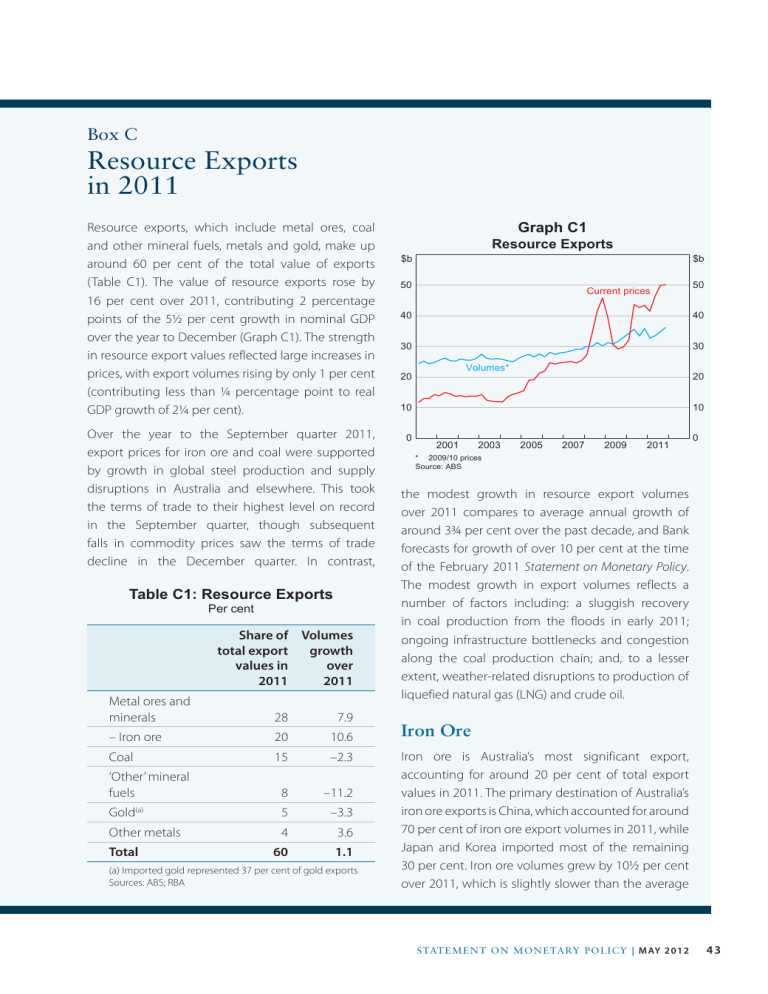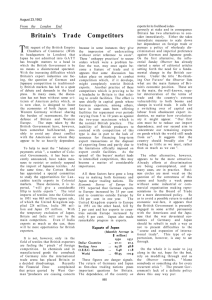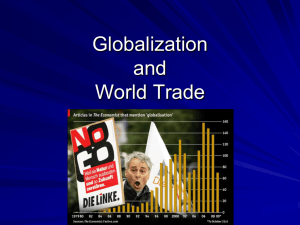Resource Exports in 2011 Box C Graph C1

Box C
Resource Exports in 2011
Resource exports, which include metal ores, coal and other mineral fuels, metals and gold, make up around 60 per cent of the total value of exports
(Table C1). The value of resource exports rose by
16 per cent over 2011, contributing 2 percentage points of the 5½ per cent growth in nominal GDP over the year to December (Graph C1). The strength in resource export values reflected large increases in prices, with export volumes rising by only 1 per cent
(contributing less than ¼ percentage point to real
GDP growth of 2¼ per cent).
Over the year to the September quarter 2011, export prices for iron ore and coal were supported by growth in global steel production and supply disruptions in Australia and elsewhere. This took the terms of trade to their highest level on record in the September quarter, though subsequent falls in commodity prices saw the terms of trade decline in the December quarter. In contrast,
$b
50
40
30
20
10
Table C1: Resource Exports
Per cent
Share of total export values in
2011
Volumes growth over
2011
Metal ores and minerals
– Iron ore
Coal
‘Other’ mineral fuels
Gold (a)
28
20
15
8
5
7.9
10.6
–2.3
–11.2
–3.3
Other metals
Total
4
60
3.6
1.1
(a) Imported gold represented 37 per cent of gold exports
Sources: ABS; RBA
0
2001 2003
* 2009/10 prices
Source: ABS
2005 2007 2009 2011 the modest growth in resource export volumes over 2011 compares to average annual growth of around 3¾ per cent over the past decade, and Bank forecasts for growth of over 10 per cent at the time of the February 2011 Statement on Monetary Policy .
The modest growth in export volumes reflects a number of factors including: a sluggish recovery in coal production from the floods in early 2011; ongoing infrastructure bottlenecks and congestion along the coal production chain; and, to a lesser extent, weather-related disruptions to production of liquefied natural gas (LNG) and crude oil.
0
Iron Ore
Volumes*
Graph C1
Resource Exports
Current prices
$b
50
40
30
20
10
Iron ore is Australia’s most significant export, accounting for around 20 per cent of total export values in 2011. The primary destination of Australia’s iron ore exports is China, which accounted for around
70 per cent of iron ore export volumes in 2011, while
Japan and Korea imported most of the remaining
30 per cent. Iron ore volumes grew by 10½ per cent over 2011, which is slightly slower than the average
STATEMENT ON MONETARY POLICY | may 2012 43
Mt
120
100
80
60
40
20 annual pace of growth over the past decade
(Graph C2). In early 2011, iron ore export volumes fell owing to production disruptions from a higherthan-average number of cyclones in the north of
Western Australia. However, iron ore export volumes recovered strongly over the rest of the year to reach new highs, reflecting expansions in the capacity of mines and rail as well as some improvements in the utilisation of port facilities.
Total
0
2003 2007
Sources: ABS; RBA
Graph C2
Iron Ore Exports
By destination
2011 2003
China
Mt
120
100
80
60
40
20
World ex-China
2007 2011
0 subtracting around ½ percentage point from real
GDP growth in the quarter.
As has been widely noted, the recovery in
Queensland coal exports from the flooding was much slower than expected. Initially, liaison contacts expected coal production to return to pre-flood levels in mid 2011, but this was delayed due to the difficulties associated with removing water from coal pits in flood-affected mines. As a result, coal shipments from Queensland only returned to their
2010 average levels in February 2012.
In addition to the flooding of mines in Queensland, ongoing supply-chain problems seem to have affected growth in coal exports over 2011.
Liaison contacts suggest that disruptions caused by congestion, unanticipated bottlenecks and maintenance of transport infrastructure have constrained growth in coal volumes over 2011, and are likely to continue to do so over the next few years.
These problems follow large capacity expansions at ports and reflect the growing size and complexity of transport networks (Graph C3). Nevertheless, coal export volumes are expected to grow solidly over the forecast period as a result of improvements in port utilisation rates and continued investment in coal mines and transport infrastructure.
Coal
Coal exports accounted for around 15 per cent of the total value of exports in 2011. While the value of coal exports rose by 22 per cent over the year, export volumes fell by around 2¼ per cent. The fall in production and the sharp jump in coal prices were largely owing to the flooding of Queensland’s
Bowen Basin coalfields (which account for over half of Australia’s coal exports) in late 2010 and early
2011. A number of mining companies and ports operated well below capacity during this time, with many mining companies declaring force majeure , which released them from liability associated with not meeting contracts due to circumstances beyond their control.
1 This resulted in coal export volumes falling by 13 per cent in the March quarter 2011 and
1 See ‘Box B: An Update on the Impact of the Natural Disasters in
Queensland’, Statement on Monetary Policy , May 2011, pp 40–43.
Mt
60
40
20
Queensland
Graph C3
Coal Exports
New South Wales
Nominal port capacity
Shipments
0
2005 2008 2011
Sources: RBA; various port authorities
2008
Mt
60
40
20
2011
0
44 ReseRve Bank of austRalia
Other Resource Exports
The performance of other resource exports – which account for a little less than half of total resource exports and one-quarter of total export values – were mixed over 2011. Export volumes of ‘other’ mineral fuels, which include LNG and crude oil, declined sharply over 2011 following disruptions to production. This largely reflected cyclone activity in early 2011 and planned maintenance of the North
West Shelf facilities in the second half of the year.
While exports of LNG are expected to grow strongly in future years following large-scale investments in production capacity, oil exports are expected to decline in line with lower production from maturing fields.
The value of Australian gold exports increased over
2011, as demand from investors attempting to find a safe haven in the face of heightened uncertainty about global economic prospects pushed gold prices to historically high levels. While gold exports accounted for around 5 per cent of total export values in 2011, it should be noted that over one-third of gold exports are re-exports of imported gold. This reflects the role of the Perth Mint, which is accredited by the London Bullion Market Association, in refining gold for global markets.
Metals export volumes increased over 2011, with an increase in base metal exports offsetting declines in exports of iron and steel. The increase in base metal exports was in line with reports of higher copper and nickel production in 2011.
STATEMENT ON MONETARY POLICY | may 2012 45





